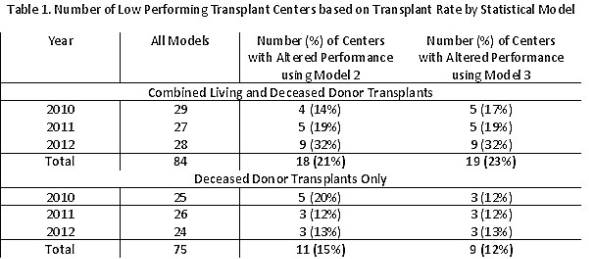Failure to Account for Critical Candidate Characteristics Significantly Biases Kidney Transplant Center Report Cards Measuring Time to Transplant
1Surgery, Montefiore Medical Center, Bronx, NY
2Medicine, Cleveland Clinic, Cleveland, OH.
Meeting: 2015 American Transplant Congress
Abstract number: 86
Keywords: Kidney transplantation
Session Information
Session Name: Concurrent Session: Economics, Policy and Ethics
Session Type: Concurrent Session
Date: Sunday, May 3, 2015
Session Time: 4:00pm-5:30pm
 Presentation Time: 4:36pm-4:48pm
Presentation Time: 4:36pm-4:48pm
Location: Room 118-C
Kidney transplant rate is proposed to be integrated into the new composite metric to evaluate center performance. Current methods adjust for PRA, blood type, re-transplantation, listing time, age and PRA*re-transplantation interaction, but not other characteristics associated with time to transplant including race, BMI, diagnosis, and insurance status. We aimed to evaluate the effect of omission of these additional factors on evaluation of center performance.Using equivalent methodology from the SRTR, we simulated report cards in 2010, 2011, and 2012 for all US kidney transplant centers using the current risk adjustment and compared results with additional adjustment (a) for race alone (model 2) and (b) race, BMI, diagnosis, and insurance(model 3). We evaluated the proportion of centers reclassified for performance (e.g. switch from below to as expected) based on additional risk adjustment to existing covariates. 84 programs had statistically lower than expected living- and deceased-donor combined transplant rates based on current methodology. With additional adjustment for race in model 2, 18(21%) programs changed statistical significance. Additional adjustment in model 3, 19(23%) programs altered performance assessment further. In an analysis of deceased-donor transplant rates alone, the change in the proportion of flagged centers was 11(15%) and 9(12%) for model 2 and 3, respectively. Results were almost identical using Bayesian instead of Fixed Effects models.  Approximately 20% of centers have altered measured kidney transplant rate performance by adjustment for race and other confounding factors. Revision of transplant rate models to adjust for characteristics associated with time to transplant should be strongly considered since centers transplanting a higher proportion of minorities, obese, diabetic and non-privately insured candidates are disproportionally likely to be identified for poor performance. Given the enhanced ramifications of pretransplant metrics, centers may be inappropriately incentivized to avoid listing more vulnerable candidate populations using current methodology.
Approximately 20% of centers have altered measured kidney transplant rate performance by adjustment for race and other confounding factors. Revision of transplant rate models to adjust for characteristics associated with time to transplant should be strongly considered since centers transplanting a higher proportion of minorities, obese, diabetic and non-privately insured candidates are disproportionally likely to be identified for poor performance. Given the enhanced ramifications of pretransplant metrics, centers may be inappropriately incentivized to avoid listing more vulnerable candidate populations using current methodology.
To cite this abstract in AMA style:
Kayler L, Schold J. Failure to Account for Critical Candidate Characteristics Significantly Biases Kidney Transplant Center Report Cards Measuring Time to Transplant [abstract]. Am J Transplant. 2015; 15 (suppl 3). https://atcmeetingabstracts.com/abstract/failure-to-account-for-critical-candidate-characteristics-significantly-biases-kidney-transplant-center-report-cards-measuring-time-to-transplant/. Accessed January 7, 2026.« Back to 2015 American Transplant Congress
